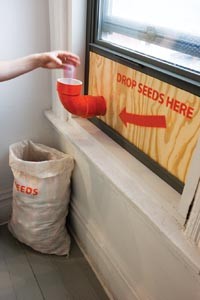The almost two-story silo situated outside the entrance to the Mattress Factory's space on the corner of Jacksonia and Monterey streets is a curiosity in the midst of the otherwise urban Central North Side. A chute at the top of the silo attaches to the building, and viewers inside can deposit small plastic capsules of seeds into the "silo-shaped vending machine."
The installation, by Claire Hoch and Dawn Weleski, speaks beautifully to the theme of Gestures. The 12th in the Mattress Factory's series highlighting small, site-specific works, curated by Katherine Talcott, was themed to suggest connections to place, and the artist's ability to be attuned to the many layers of an environment.
Once, on the North Side, some 100 acres of land were designated as a communal area for livestock grazing. Hoch and Weleski were particularly interested in how the resources and products of the pastureland, called The Commons, were distributed in the community. In "Redistributing the Commons," Hoch and Weleski use the silo as a way to, poetically, newly apportion the common land itself.
Each capsule that gallery-goers drop into the silo contains seeds, soil and the address and photograph of a sidewalk tree-plot which, although owned by the city, is maintained by the resident. One can obtain a capsule (24 hours a day) by opening a door on the silo at street level. Participants are asked to plant their seeds in the given plot, thereby reclaiming "common land." The fact that a "product" from inside the gallery is disseminated outside to the community at large adds another layer to this thought-provoking work.
Meanwhile, Keny Marshall's "Mechanical Operation -- Intersecting Rotational Equipment" cleverly points out our reliance on other's experience of an environment to fully appreciate or understand our own. In a room on the annex's third floor, around the corner from the staircase, is installed a crank handle. It connects to a mechanism made of metal rods and joints that travels down the stairwell and ends in a rotating set of discs hanging on the wall above the second-floor landing. The participant turning the handle cannot see the resultant disc rotation: Another viewer (who likewise can't see the handle-turner) must be stationed at the stairwell to report back.
Carin Mincemoyer's "Migrating Birds Mimicking the Structure of Polyethylene Molecules" hangs along the ceiling of the second-floor hallway adjacent to Marshall's piece. Mincemoyer is thinking about the environment literally: Because synthetic polymers do not biodegrade readily and nothing can consume them, they will outlast any of us. The small birds in this installation, linked by dowels to form molecular models, "fly" down the narrow hallway.
Mincemoyer suggests that her birds might fly in these formations because evolution has taught them to mimic the structures of the durable molecules -- or perhaps because the consumption of plastic particles in their food "reprogrammed" their instincts. Either way, it is a poignant and thoughtful commentary on the relationships between us and our "connections to place," as well as to the entities in that place.
Gestures also includes Atticus Adams' ethereal undulating waves of aluminum mesh that float through the museum annex's large main-floor gallery; Amber Coppings' lovely fabric installation; and works by artists and artist teams including Stephanie Flom and Peter Oresick; Kate Joranson; Than Htay Maung; Risë Nagin; Ian Page; Vanessa Sica and Chris Kasabach; Josh Tonies; R. Weis; Ray Werner; Gregory Witt; and Brett Yasko.
Gestures: An Exhibition of Small Site-Specific Works continues through June 21. Mattress Factory, 500 Sampsonia Way, North Side. 412-231-3169 or www.mattress.org















